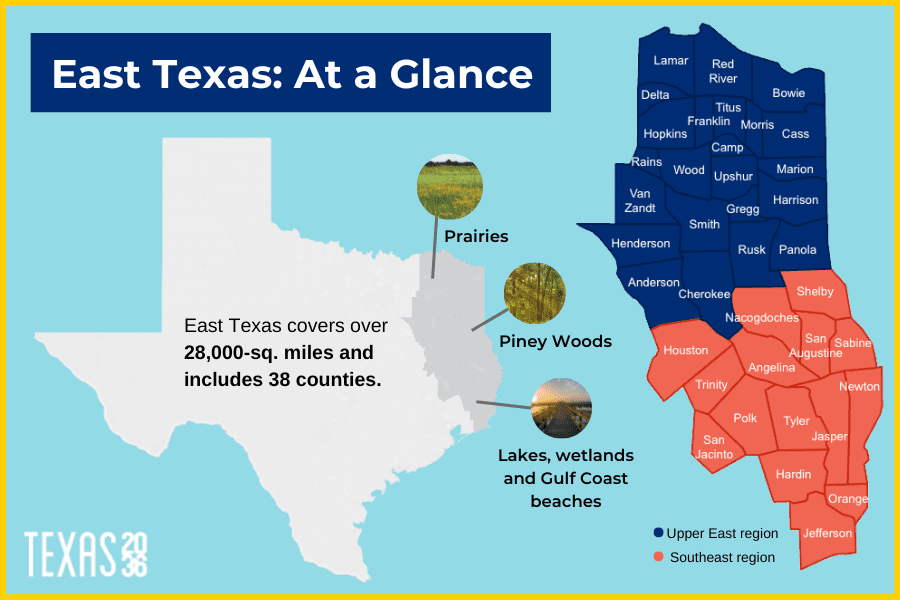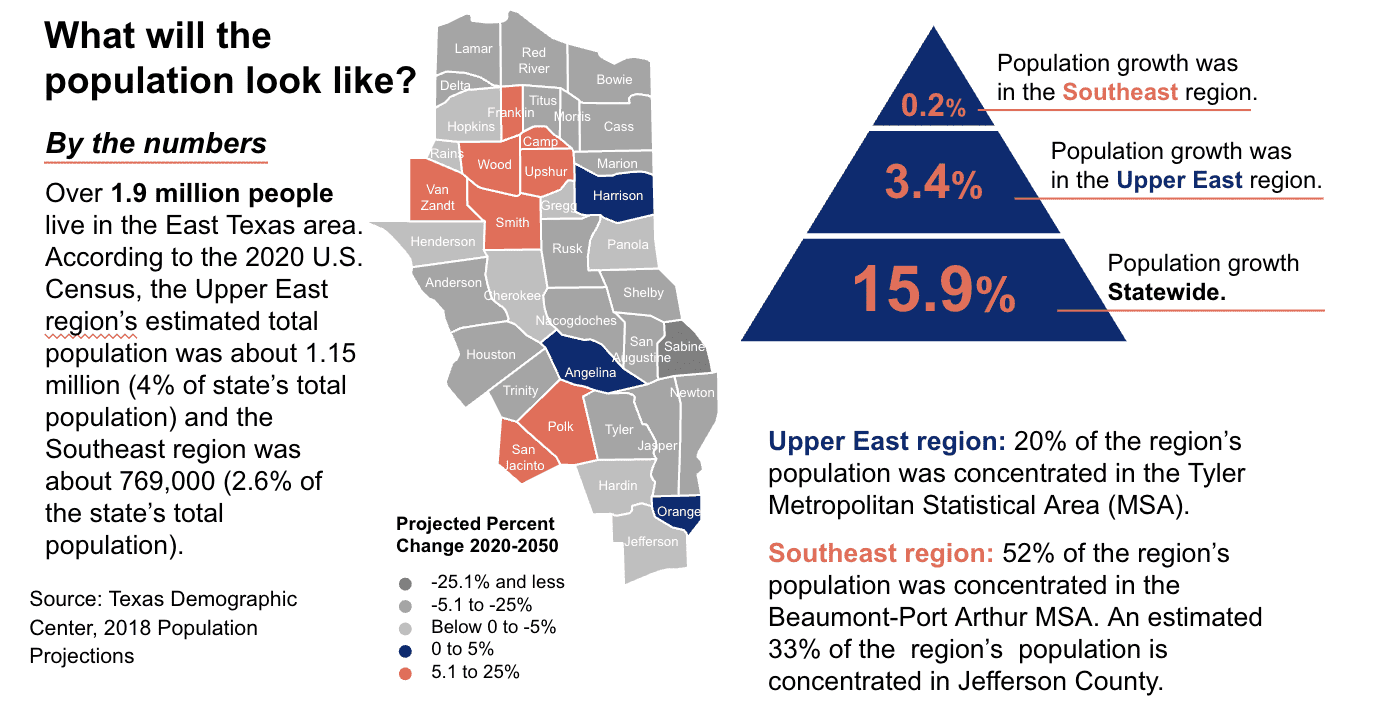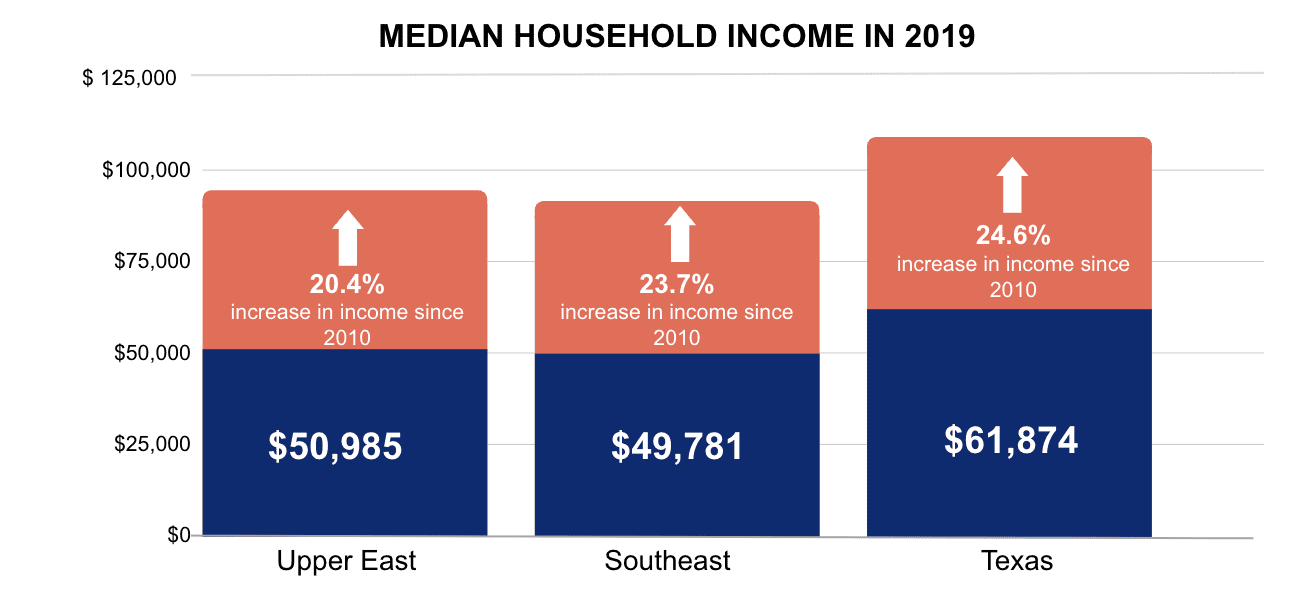East Texas: The region at a glance

But first, what makes up East Texas?
East Texas includes 38 counties and is divided by the Upper East region (23 counties) and Southeast region (15 counties).
- The Upper East region includes: Anderson, Bowie, Camp, Cass, Cherokee, Delta, Franklin, Gregg, Harrison, Henderson, Hopkins, Lamar, Marion, Morris, Panola, Rains, Red River, Rusk, Smith, Titus, Upshur, Van Zandt, and Wood counties.
- The Southeast region includes: Angelina, Hardin, Houston, Jaspar, Jefferson, Nacogdoches, Newton, Orange, Polk, Sabine, San Augustine, San Jacinto, Shelby, Trinity, and Tyler counties.
The area, which covers over 28,000-square miles, ranges from the Piney Woods bordering Louisiana and Arkansas to the prairies on the eastern edge of the Dallas-Fort Worth Metroplex, and from Oklahoma south to the lakes, wetlands and beaches of the Gulf of Mexico.
Population in East Texas 👨👩👧👦

By the numbers: Over 1.9 million people live in the East Texas area. According to the 2020 U.S. Census, the Upper East region’s estimated total population was about 1.15 million (4% of state’s total population) and the Southeast region was about 769,000 (2.6% of the state’s total population).
- Upper East region: 20% of the region’s population was concentrated in the Tyler MSA.
- Southeast region: 52% of the region’s population was concentrated in the Beaumont-Port Arthur MSA. An estimated 33% of the region’s population is concentrated in Jefferson County.
Where’s the growth?
According to the 2020 U.S. Census:
- 3.4% population growth was in the Upper East region.
- 0.2% population growth was in the Southeast region.
- 15.9% growth statewide.
0-5% population change is predicted between 2020-2050, according to the Texas Demographic Center’s 2018 prediction.
Where it’s booming in East Texas 📈
According to the Texas Comptroller of Public Accounts, about $86.2 billion in Gross Domestic Product was earned in East Texas in 2020, accounting for roughly 5% of Texas’ GDP of $1.8 Trillion.
A breakdown by region:
- $49.3 Billion in GDP was earned in the Upper East region in 2020. This was about 3% of Texas’ GDP.
- $36.9 Billion in GDP was earned in the Southeast region in 2020. This was about 2% of Texas’ GDP.
East Texas’ largest industries by employment levels are in restaurants, education, and health care services. Retail is another top industry in the Upper East region and public safety, building and utility construction are top industries in the Southeast region.
The metropolitans with the most employed in East Texas are Longview MSA, Texarkana MSA, Tyler MSA and the Beaumont-Port Arthur MSA.
- 57.1% in the Beaumont-Port Arthur MSA
- 28.8% in the Longview MSA
- 24.3% in the Tyler MSA
- 13.1% in the Texarkana MSA
Household incomes in East Texas 💰

According to the 2020 U.S. Census:
Upper East region: The area had a median household income of $50,985 in 2019. This was a 20.4% increase from $42,341 in 2010.
Southeast region: The area had a median household income of $49,781 in 2019. This was a 23.7% increase from $40,566 in 2010.
How does it compare statewide? Median household income in Texas was $61,874 in 2019, which was up 24.6% from 2010.
The big picture: To increase the share of Texas households earning a living wage, we need to prepare new workers and retrain existing workers for higher-paying jobs that will be in-demand in the coming years.
East Texas: Education-to-Workforce Pipeline 🧑🏭
Southeast region workers with an associate degree or certificate earned an average of $2,167 more annually than those in jobs requiring less than postsecondary education or training. Those with at least a bachelor’s degree earned an average of $34,867 more.
The big picture: A postsecondary education offers opportunity for greater job prospects, workplace advancement, higher wages and the development of a richer world view.
- 84.5% over 25 in the Upper East region with at least a high school diploma, 2019
- 19.3% over 25 in the Upper East region with a bachelor’s degree or higher, 2019
- 84% over 25 in the Southeast region with at least a high school diploma, 2019
- 17% over 25 in the Southeast region with a bachelor’s degree or higher, 2019
Sources: U.S. Census Bureau; U.S. Bureau of Labor Statistics and U.S. Bureau of Economic Analysis
Health care in East Texas 🩺
In 2019, the rate of uninsured in both regions:
- Upper East region: Uninsured rate ranged from a low of 16.8% in Cass County to a high of 25% in Titus County; the overall rate for the region was 21.2%, the second highest in the state.
- Southeast region: Uninsured rate ranged from a low of 16.2% in Hardin County to a high of 25.8% in Shelby County; the overall rate for the region was 20.7%.
Note: Uninsured population includes under 65 (ages 0-65)
Source: U.S. Census Bureau, SAHIE (Small Area Health Insurance Estimates)
